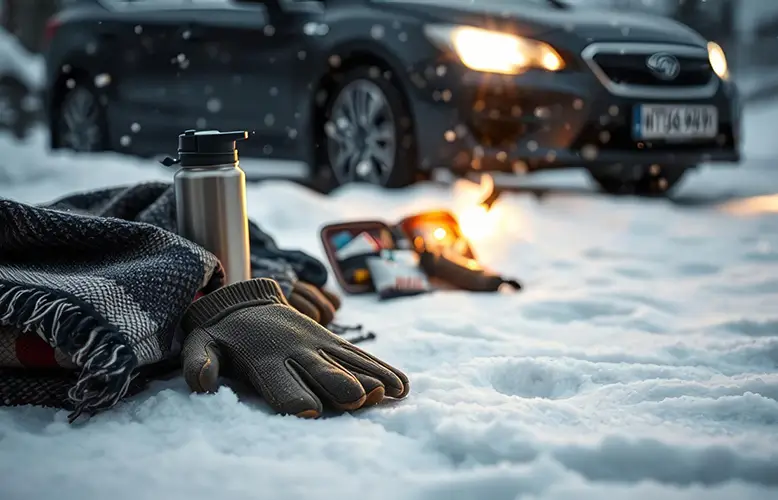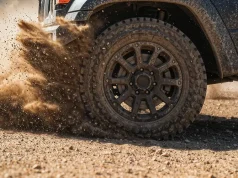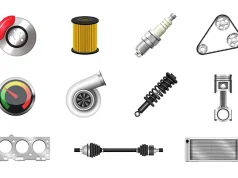What if the real key to safer, calmer winter trips isn’t a bigger engine or new tires—but how warm you feel behind the wheel?
From Denver’s predawn chill to lake-effect blasts in Buffalo, winter driving comfort is more than a perk. It shapes reaction time, grip, and focus. In this guide, you’ll get cold weather driving tips that keep you alert, cut fog, and help you arrive ready—not worn out.
We’ll blend safety science with simple habits you can use today. Think smart HVAC settings that clear glass fast, a cozy car in winter without wasting fuel, and quick upgrades like a heated car seat cover. You’ll also see how maintenance—coolant service, seals, tires, and battery checks—supports winter commute safety without extra idling.
Expect practical steps for U.S. winters, from the Rockies to the Northeast, that warm the cabin, protect visibility, and preserve energy. The result: steady hands, loose shoulders, and fewer cold-weather surprises.

Key Takeaways
- Warmth boosts alertness and cuts stiffness, supporting winter commute safety.
- Use fast, clear HVAC steps to prevent fog while keeping a cozy car in winter.
- Adopt cold weather driving tips that save fuel and battery, not just time.
- Quick wins—remote start, seat heaters, and a Heated auto seat cover—pay off fast.
- Routine checks on coolant, seals, tires, and the battery lock in reliable heat.
- Balance comfort with visibility to keep control on icy, busy roads.
Why Winter Driving Comfort Matters for Safety and Well-Being
Being comfortable in your car affects how you drive. A warm cabin keeps your hands steady and your mind clear. This is crucial when the road is slippery.
How warmth affects reaction time and focus
Cold air makes your nerves slower and muscles tighter. This can lead to slower steering and braking. Keeping the car warm helps you stay alert and focused.
Warm hands also improve your grip on the wheel. This means you can steer and brake more smoothly.
Reducing fatigue and stiffness on long commutes
Cold weather stiffens your body on long drives. Warm seats and a heated steering wheel help. They keep you comfortable and prevent fidgeting.
Good lumbar support keeps you from slouching. This helps you stay focused and make smoother turns.
The connection between cabin temperature and safe driving habits
A stable cabin temperature stops you from overgripping the wheel. It also prevents you from using too much defrost. This keeps your eyes and hands comfortable.
Warmth also stops you from taking risks, like scraping frost off the windshield. Better visibility and relaxed muscles make driving safer.
Essential Vehicle Prep for Cold Weather Comfort
Winter car prep is easy with a few smart steps. Focus on what makes your car warm up fast. Small checks now mean no shivers later.
Battery, fluids, and tire checks before the first freeze
Check your battery and make sure it has enough battery cold cranking amps. If it’s close, get a new one before it gets cold. Cold weather makes batteries weaker.
Use a 50/50 ethylene glycol mix to keep your heater core warm. Make sure your thermostat works right so the engine doesn’t get too cold. Use washer fluid that works in cold weather to keep your windshield clear.
Check your tire pressure every week. It goes down about one PSI for every 10°F. Think about getting winter tires like Michelin X-Ice or Bridgestone Blizzak. They grip better and make your car warm up faster.
Seals, insulation, and preventing drafts
Look at the weatherstripping around doors, hatches, and windows. Make sure the door seal maintenance is good. Replace old seals or use silicone to keep them flexible.
Check that the HVAC recirculation door works well. This stops cold air from getting in. Use a frost cover or insulating sunshade at night to keep your car warm.
Quick-win upgrades that boost cabin warmth
Get all-weather floor liners to keep slush out and lower humidity. An insulated windshield cover saves time and reduces ice.
Use a block heater to warm up coolant and oil before driving. This makes your car warm up faster. Consider a heated steering wheel or a retrofit kit. On older cars, make sure the blend door works right so warm air gets to the vents.
These steps make your car warm up better for cold starts.
Cabin Climate Control: Smart Settings for Fast, Even Heat
Warm up the cabin with intent, not guesswork. Use HVAC best practices winter to get heat spreading quickly without wasting fuel or battery. Start gentle, keep air moving, and watch moisture so you prevent window fog on the go.
Defrost vs. floor vents: best practices for heat distribution
Begin with balanced defrost settings and a moderate fan. Fresh air mode pulls in dry air that clears frost fast. As the glass clears, shift airflow toward the floor vents; rising heat then warms your legs, torso, and face in sequence.
Avoid slamming max heat at startup. A steady ramp protects the windshield from thermal shock and feels better. Keep recirculation off until the windows are clear to reduce humidity and prevent window fog.
Auto climate modes and remote start tips
Let auto climate target about 70°F. Modern systems from brands like Toyota, Ford, BMW, and Tesla tune fan speed, blend doors, and air source for even warmth. This is the core of HVAC best practices winter for daily driving.
Use a brief remote start warm-up—about three to five minutes—to clear glass and stabilize idle. If your car supports memory for heated seats and a heated wheel, enable them so comfort rises fast even on short trips.
Managing humidity to avoid foggy windows
Good cabin humidity control starts before you drive. Knock snow off boots, use rubber mats, and keep wet gear bagged. With defrost on, the A/C compressor helps dry the air even in cold weather.
Swap clogged cabin filters to improve airflow and dehumidifying. On bitter days with a full car, crack a rear window briefly to vent moist air and prevent window fog without chilling the cabin.
| Goal | Action | Why It Works | Pro Tip | Clear glass fast |
| Use defrost settings with moderate fan and fresh air | Dry outside air removes moisture and frost quickly | Ramp heat gently to avoid glass stress | ||
| Even cabin warmth | ||||
| Shift airflow to floor vents after initial clear | Warm air rises, creating smooth convection | Target ~70°F in auto mode for steady comfort | ||
| Save time and fuel | ||||
| Remote start warm-up for 3–5 minutes | Clears windows without long idling | Enable seat and wheel heat memory for faster perceived warmth | ||
| Control humidity | ||||
| Run A/C with defrost; keep recirculation off at start | Dehumidifies cabin air to prevent window fog | Crack a rear window briefly during heavy moisture build-up | ||
| Max airflow | ||||
| Replace dirty cabin air filter | Improves air volume and drying efficiency | Check filter before peak winter travel |
Heated Seating and Accessories to Transform Your Drive
Target warmth at your core and hands to feel comfortable faster. Localized heat trims warm-up time and can lower HVAC demand. That’s where seat heater benefits and a heated steering wheel work together to make winter driving feel easy.
Benefits of built-in heated seats and steering wheels
Factory systems from brands like Toyota, Ford, BMW, and Subaru use radiant elements that warm you in minutes. The result is steady comfort without blasting hot air. Many cars pair seat heater benefits with a heated steering wheel, so your fingers stay nimble and you can skip bulky gloves.
Most OEM setups include multi-level controls and auto shutoff. That balance supports safety and helps reduce power consumption car heaters, especially in hybrids and EVs on cold mornings.
Choosing a heated car seat cover for universal compatibility
If your car lacks built-ins, a 12V seat warmer can be a smart upgrade. Look for UL- or ETL-listed models with adjustable heat, thermostat or thermistor protection, and non-slip backing. Sojoy, Wagan, and KINGLETING offer popular options that fit many bucket seats.
Check for side airbag-friendly designs and route cords clear of belt latches to keep them as crash-safe accessories. Secure fit improves comfort and preserves sensors under the seat.
Power draw, safety features, and installation basics
Typical 12V cushions draw about 35–60W per seat. Verify your outlet rating and avoid stacking devices that spike power consumption car heaters on a single circuit. Use the fuse value recommended by the maker and inspect cords for wear.
Install on a cool, dry seat and tighten straps so the pad does not shift. Unplug a 12V seat warmer when parked if your outlet is always on. Avoid thick add-on cushions that could affect occupant detection.
| Option | Typical Power Draw | Key Advantages | Safety Highlights | Best For |
| OEM heated seat | 40–100W per seat | Fast, even warmth; integrated controls; strong seat heater benefits | Auto shutoff; factory-tested as crash-safe accessories | Daily drivers seeking seamless comfort |
| OEM heated steering wheel | 10–20W | Keeps hands agile; reduces need for gloves | Built-in timers and thermal limits | Precise control in cold traffic |
| 12V seat warmer (Sojoy/Wagan/KINGLETING) | 35–60W per seat | Affordable retrofit; portable across vehicles | UL/ETL listings; overheating protection | Cars without factory heat |
| Combined seat + wheel | ~50–120W total | Rapid comfort with lower HVAC use | Layered safeguards; clear cord routing | Fuel or battery savings in winter |
Layering and Winter Apparel That Works Behind the Wheel
Comfort begins with the right winter driving clothes. Look for items that breathe, move freely, and fit well under seat belts. This combo works great with heated seats, keeping you focused on driving.
Breathable base layers vs. bulky outerwear
Choose a base layer merino from brands like Smartwool or Icebreaker. Or go for a light polyester blend from Patagonia. Add a thin fleece or softshell mid-layer to keep warm without bulk.
Big parkas can block your movement and reduce belt and airbag performance. So, remove them before driving.
Keep a compact vest handy to adjust warmth as the cabin heats up. This mix feels light yet steady. It also helps manage sweat to avoid chilling later.
Gloves, hats, and footwear that preserve control
Opt for thin insulated gloves with good grip. Think leather or softshell with silicone palms from Hestra or The North Face. Avoid thick mittens that dull finger feel on the wheel and buttons.
For driving in winter, switch from heavy snow boots to insulated hiking shoes or winter sneakers by Salomon, Merrell, or Nike ACG once the snow is knocked off. A firm sole improves pedal feel and helps you modulate brakes on slick streets.
Changing from outdoor coat to driving layers
Use a quick routine: warm the cabin briefly, remove the heavy coat, buckle up, then drape the coat over your lap for extra warmth. This keeps restraints working as designed and supports safe winter apparel choices.
Stash wet outerwear in a waterproof tote to cut humidity and window fog. Keep a light mid-layer within reach so you can add heat fast during fuel stops or when the car cools down.
- Prioritize winter driving clothing that breathes and flexes.
- Rely on base layer merino and a soft mid-layer over bulk.
- Use thin insulated gloves and firm-soled driving footwear winter models for control.
- Follow a belt-first routine to maintain safe winter apparel standards.
Warmth on the Go: Blankets, Hand Warmers, and Emergency Kits
Cold snaps can arrive fast, and comfort fades even faster when your heater lags. Pack smart car survival gear so you stay warm, alert, and ready for detours. A well-built emergency winter car kit also supports road safety winter without taking over your trunk.

Compact thermal blankets and stowable options
Slip a mylar blanket car pack behind each seat. These reflective sheets trap body heat and weigh almost nothing. Add a compact fleece or a thin wool throw for passengers on long drives.
For extra comfort, consider a 12V heated throw from brands like RoadPro or Sojoy with auto shutoff and low draw. Keep cords tidy so they do not snag belts or pedals.
Safe use of portable warmers in vehicles
Air-activated warmers from HotHands or Grabber are simple and steady. Place them in gloves or near wrist arteries to boost warmth where blood flows. They help when the cabin is slow to heat.
If you prefer reusable hand warmers, choose UL-listed rechargeable models. Avoid charging while other outlets power defrost tools or a dashcam. Never use propane heaters in a closed cabin due to carbon monoxide and fire risk.
Building a cold-weather emergency kit
Think beyond heat. A balanced emergency winter car kit covers traction, power, light, food, and visibility. Store items in a bright bin so they are easy to grab in snow.
- Traction and tools: folding shovel, traction boards or cat litter, tow strap, ice scraper/brush, tire inflator with sealant
- Power and light: jumper cables or a lithium jump starter, flashlight with spare batteries, phone charger
- Warmth and wear: mylar blanket car set, compact fleece, reusable hand warmers, extra gloves, hat, and vacuum-sealed base layers with socks
- Safety and sustenance: first aid kit, water, calorie-dense snacks, reflective triangle, high-visibility vest
Rotate snacks and check batteries at the start of each cold spell. This habit strengthens road safety winter and keeps your car survival gear ready when the weather turns.
Stay Warm on the Road: The Secret to Comfortable Winter Drives
Smart winter driving strategies make every commute smoother and safer. Aim for comfort and safety winter without wasting fuel or battery. With efficient car heating and clear visibility, the cabin feels calm and focused from the first mile.
Key strategies to make every mile cozier
Precondition the cabin with a remote start or an EV app before you step outside. Turn on heated seats and the heated steering wheel first; they warm you faster at a lower energy cost.
Direct airflow to the floor and use fresh air mode at the start to purge moisture. Keep windows clear with steady defrost and A/C dehumidification. If your car lacks factory heaters, add a heated seat cover from brands like Turtle Fur or Amazon Basics for immediate warmth.
Balancing comfort, energy efficiency, and safety
Set a moderate cabin temperature and rely on localized heat to stretch range and fuel. Drive gently after startup so the engine and drivetrain warm evenly. Never trade visibility for heat—defrost and defog come first.
Brush off snow from coats and mats to cut humidity and frost-up. These winter driving strategies support efficient car heating while keeping hands and eyes ready for the road.
Top mistakes to avoid in extreme cold
- Over-idling, which wastes fuel and can build soot in engines with direct injection.
- Wearing a thick coat under the seat belt, which reduces restraint effectiveness and control.
- Ignoring tire pressure warnings; cold drops PSI and lengthens stopping distance.
- Using recirculation too early; it traps moisture and fogs glass.
- Neglecting the cabin air filter, which restricts airflow and weakens defrost.
- Relying on unapproved in-cabin fuel heaters; stick with OEM systems and UL-listed electrics.
- Blocking HVAC sensors or floor vents with bags or mats, which cuts efficient car heating.
| Action | Why It Works | Energy Impact | Safety Benefit |
| Precondition via app or remote start | Warms cabin and clears glass before driving | Uses grid power or short engine run | Improves visibility from the first block |
| Heated seats and wheel first | Local heat warms body faster than air | Lower draw than full cabin heat | Keeps hands nimble and focused |
| Fresh air, then controlled recirculation | Purges moisture to prevent fog | Moderate; reduces A/C load later | Clear windows under changing temps |
| Moderate temp with floor vents | Warms feet and circulates evenly | Efficient car heating with fewer spikes | Steady comfort aids attention |
| Regular cabin filter replacement | Restores airflow and defrost strength | Less blower strain | Faster de-icing in storms |
| Remove snow from clothing and mats | Cuts cabin humidity load | Less A/C dehumidification needed | Reduces sudden fogging |
| Respect TPMS alerts | Maintains grip and braking | Optimizes rolling resistance | Shorter stops on slick roads |
Energy Efficiency: Save Fuel While Staying Toasty
Comfort and efficiency can go hand in hand. A few smart moves help you stay warm without wasting gas or battery. These tips are great for daily commutes and weekend trips.

Warming up without wasting gas or battery
Start the engine, clear the glass, and drive gently after 30–60 seconds. This reduces idling, saves fuel, and warms the powertrain faster. Keep RPMs low until the gauge climbs and the vents blow steady heat.
Use heated seats and a warm steering wheel. This lets you set the cabin temperature lower. It’s a simple way to stay comfortable while saving fuel.
EV-specific heating tips and preconditioning
Preheat while plugged in with the vehicle app. EV preconditioning warms the cabin and battery before you leave. It protects range and restores strong regen. Brands like Tesla, Hyundai, Kia, and Ford support scheduled departure for a smooth start.
Choose a heat pump EV if possible. It uses less energy than resistive heat. Use seat and wheel heaters first, then raise the cabin target only as needed. This helps retain heat and stretch miles.
Insulation hacks to retain heat longer
Use thermal windshield and side window shades when parked to retain heat car. Check door seals and the cabin filter housing to prevent drafts. A tight seal keeps the air warm and stable.
Add a cargo mat and close the rear-seat pass-through if equipped. This blocks cold air from the trunk. In small cabins, crack rear vents partway to push warmth forward. These tips keep you comfortable while reducing idling.
Maintenance Habits That Keep the Heat Flowing
Cold snaps test every part of your HVAC system. A few steady habits keep warm air steady on your commute. They also reduce surprise repairs and help your defroster respond fast when frost hits the glass.
Heater core, thermostat, and coolant system health
If the vents blow lukewarm air, a partial clog may be the culprit. A timely heater core flush restores flow through those narrow tubes. It helps recover outlet temps.
Follow the factory coolant service interval to protect passages and prevent corrosion. Make sure the radiator cap maintains pressure.
Watch your temperature gauge. If it stays low, a stuck-open valve is likely. Thermostat replacement can bring the engine back to proper heat. During checks, look at the water pump for seepage and listen for bearing noise that hints at poor circulation.
Replacing cabin air filters for better airflow
Restricted filters choke the blower and slow defogging. A routine cabin filter change every 12,000–15,000 miles, or sooner in dusty routes, restores airflow. It cuts strain on the fan.
In city traffic, an activated carbon option helps reduce odors when using fresh air mode. This simple swap often makes heat feel stronger at lower fan speeds. It keeps noise down and helps preserve energy on long drives.
Detecting and fixing drafts, leaks, and squeaks
Drafts cool the cabin and confuse climate sensors. Close a dollar bill in the door to check seal grip; weak resistance points to compression loss. A needed weatherstripping repair is required.
Whistling near window channels or mirror mounts suggests small leaks that steal warmth. Use silicone-safe care on seals to prevent freezing shut. Inspect grommets and firewall pass-throughs for gaps.
Quieting rattles also matters, since squeaks can mask subtle tire slip sounds on icy roads.
Quick habit checklist
- Schedule coolant service interval checks with each season change.
- Plan a heater core flush if outlet temps fade over time.
- Pair thermostat replacement with fresh coolant when the gauge reads low.
- Set reminders for your next cabin filter change to keep air moving.
- Walk the doors and trunk for a fast weatherstripping repair where drafts persist.
Conclusion
Here’s your winter driving summary: warmth is a safety plan, not a luxury. Start by preconditioning your car’s cabin. Use smart HVAC settings and rely on heated touchpoints. Wear light layers that allow for easy movement.
Keep your glass clear and hands responsive. Use energy wisely for safe trips on American winter roads.
Prepare before the cold hits. Service your coolant and thermostat, test the battery, and replace the cabin air filter. Check the weather seals too.
Every day, brush off snow before driving. Start with defrost and fresh air. Then, switch to floor heat and use warmers like heated seats or a heated wheel.
Carry the right gear. Pack a thermal blanket, hand warmers, jumper cables, a scraper, and a small first-aid kit. This way, cold snaps won’t catch you off guard.
With a few steady habits and tools, driving in winter becomes cozy and safe. Turn tough conditions into safe warm commutes.
That’s the core of cold weather car comfort: prepare early, manage climate with intent, and maintain your vehicle on schedule. Follow these steps, and every mile feels calmer, clearer, and safer all season long.
FAQ
What cabin temperature is best for alert, comfortable winter driving?
Aim for 68–72°F. This range helps you react quickly and keeps your hands and eyes comfortable. Add heated seats or a steering wheel for faster warmth without using too much heat.
How can I warm up my car quickly without wasting fuel or battery?
Start by idling for 30–60 seconds, then drive gently. Use defrost with outside air to clear the glass. Switch to floor vents and turn on heated seats and wheel. For EVs, precondition while plugged in and use heat pumps if you have them.
Do heated seats really save energy in winter?
Yes. Heated seats warm you up faster than the air, so you can use less heat. This saves fuel in gas cars and keeps EVs’ range longer.
What quick upgrades make the cabin feel warmer?
Add all-weather floor liners and an insulated windshield cover. Use a UL- or ETL-listed heated seat cushion. Consider a block heater and make sure your blend door works right.
Which tires help with winter comfort and control?
Winter tires like Michelin X-Ice or Bridgestone Blizzak stay flexible in cold weather. They improve grip and reduce wheelspin. This makes warm-up faster and the ride smoother on icy roads.
How do I prevent foggy windows without overusing the defroster?
Start with defrost and outside air, then run the A/C to dehumidify. Shake off snow before getting in. Replace the cabin air filter and use rubber mats. Crack a rear window briefly if passengers add moisture.
Is remote start good or bad for efficiency?
It’s good in short bursts. Limit remote start to 3–5 minutes to clear glass and warm up. Use automatic heated seat and wheel memory to feel warm faster with less idling.
What maintenance keeps the heater blowing hot?
Service coolant on schedule and check the thermostat. Keep the heater core clean. Inspect the radiator cap and water pump for proper pressure and flow. Replace cabin filters every 12,000–15,000 miles.
How can I stop cold drafts inside the car?
Check door and window weatherstripping and perform a dollar-bill test. Condition seals with silicone. Make sure recirculation and blend door actuators work, and check for gaps in the firewall.
What’s the safest way to use portable warmers in the car?
Use air-activated hand warmers like HotHands or UL-listed rechargeable units. Keep cords clear of pedals and seatbelt latches. Never use propane heaters in a vehicle due to fire and carbon monoxide risk.
Are bulky coats safe to wear while driving?
No. Thick parkas can reduce seatbelt effectiveness and restrict movement. Warm the cabin briefly, remove the coat, buckle up, and place the coat over your lap for extra warmth without compromising safety.
What should a winter emergency kit include?
Pack a mylar blanket, fleece throw, shovel, traction aids, jumper cables or a lithium jump starter, flashlight, first aid kit, water, snacks, extra gloves and hats, phone charger, reflective triangle, ice scraper, tow strap, and a tire inflator.
How do I set auto climate for fast, even heat?
Select Auto, target about 70°F, and let the system balance fan and vents. Start with outside air to purge humidity, then shift airflow to floor vents once glass is clear. Avoid blasting max heat right away to reduce thermal shock.
What apparel works best behind the wheel in winter?
Wear breathable base layers like merino wool or polyester, add a light fleece or softshell, and choose thin, grippy driving gloves. Swap heavy snow boots for firm-soled winter shoes after clearing snow from the tread.
Why does tire pressure matter for warmth and safety?
Pressure drops about 1 PSI for every 10°F. Low PSI hurts traction, increases stopping distance, and makes warm-up less efficient. Check weekly in winter for consistent grip and stable handling.
How do EV drivers stay warm without draining range?
Precondition while plugged in, use heated seats and steering wheel, and keep the cabin setpoint moderate. If your EV has a heat pump, rely on it for efficient heating, and schedule departures to warm the battery for regen.
What are the biggest mistakes to avoid in extreme cold?
Over-idling, driving in a thick coat, ignoring low tire pressure, using recirculation too early, neglecting cabin filters, and blocking vents. Skip unapproved in-cabin fuel heaters and always prioritize clear glass over extra warmth.





